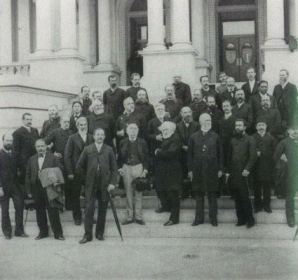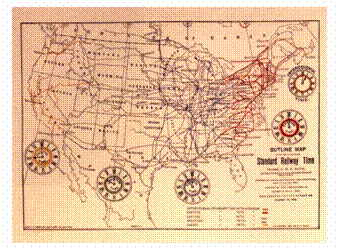Quirico Filopanti (continued)
| In 1858, during his exile in London, Filopanti came up with the idea of "longitudinal days" (time zones), which he described in his book Miranda! He suggested dividing the surface of the globe into 24 zones, each one bound by two meridians 15 degrees apart. Each zone would have the time corresponding to an average meridian, located 7.5 degrees from each side. In this way, States included in the same time band would have the same time. The difference in time between States in different time bands would always be a whole multiple and the different times would easily relate to each other. In addition, the time in these bands would not be too far removed from local time: there was never more than half an hour's difference. |
Fig. 1:
Map
featuring William F. Allen's proposal in 1883 for the introduction of
Standard Railway Time. The clocks show the time which the railways of the
same colour on the map should adopt. |
 |
Fig. 2:
Photograph of participants at the International Meridian Conference in
Washington in 1884. (Credit: On Time di Carlene E. Stephens Bulfinch, Press Book, Boston, 2002) |
However, Filopanti's suggestion never left the pages of his book and, despite all the good scientific arguments in favour of time zones, it was the American railway companies that introduced them purely for practical reasons. In 1833 the railways imposed an official time, similar to time zones, which divided the United States of America into four zones, in order to put a stop to the confusion which complicated the running of their trains and reduced their profits. And in 1884, the representatives of 25 countries, meeting together in Washington for the first conference on the fundamental meridian, proposed Greenwich as the zero meridian and divided the Earth into 24 time zones, each separated by one hour. This was perhaps the first example of "globalization".
The real inventor, Filopanti, was not mentioned because nobody knew about his work. In fact, the father of this revolution, which allowed man to take control of an absolute time, is often considered to be Sanford Fleming, a Canadian engineer of Scottish origin.
|
|
